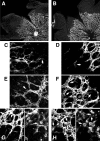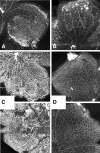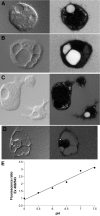Chloride intracellular channel protein-4 functions in angiogenesis by supporting acidification of vacuoles along the intracellular tubulogenic pathway
- PMID: 19197003
- PMCID: PMC2665767
- DOI: 10.2353/ajpath.2009.080625
Chloride intracellular channel protein-4 functions in angiogenesis by supporting acidification of vacuoles along the intracellular tubulogenic pathway
Abstract
Endothelial cells form capillary tubes through the process of intracellular tubulogenesis. Chloride intracellular channel (CLIC) family proteins have been previously implicated in intracellular tubulogenesis, but their specific role has not been defined. In this study, we show that disruption of the Clic4 gene in mice results in defective angiogenesis in vivo as reflected in a Matrigel plug angiogenesis assay. An angiogenesis defect is also apparent in the retina, both in the decreased spontaneous development of retinal vasculature of unstressed mice and in the dramatically decreased angiogenic response of retinal vessels to an oxygen toxicity challenge. We found that endothelial cells derived from Clic4(-/-) mice demonstrated impaired tubulogenesis in three-dimensional fibrin gels compared with cells derived from wild-type mice. Furthermore, we found that tubulogenesis of wild-type cells in culture was inhibited by both an inhibitor of CLICs and an inhibitor of the vacuolar proton ATPase. Finally, we showed that vacuoles along the endothelial tubulogenesis pathway are acidic in wild-type cells, and that vacuolar acidification is impaired in Clic4(-/-) cells while lysosomal acidification is intact. We conclude that CLIC4 plays a critical role in angiogenesis by supporting acidification of vacuoles along the cell-hollowing tubulogenic pathway.
Figures











Similar articles
-
Chloride intracellular channel-4 is a determinant of native collateral formation in skeletal muscle and brain.Circ Res. 2009 Jul 2;105(1):89-98. doi: 10.1161/CIRCRESAHA.109.197145. Epub 2009 May 28. Circ Res. 2009. PMID: 19478202 Free PMC article.
-
Chloride intracellular channel 4 is involved in endothelial proliferation and morphogenesis in vitro.Angiogenesis. 2009;12(3):209-20. doi: 10.1007/s10456-009-9139-3. Epub 2009 Feb 27. Angiogenesis. 2009. PMID: 19247789 Free PMC article.
-
Aberrant chloride intracellular channel 4 expression contributes to endothelial dysfunction in pulmonary arterial hypertension.Circulation. 2014 Apr 29;129(17):1770-80. doi: 10.1161/CIRCULATIONAHA.113.006797. Epub 2014 Feb 6. Circulation. 2014. PMID: 24503951 Free PMC article.
-
Role of the vascular endothelial growth factor isoforms in retinal angiogenesis and DiGeorge syndrome.Verh K Acad Geneeskd Belg. 2005;67(4):229-76. Verh K Acad Geneeskd Belg. 2005. PMID: 16334858 Review.
-
Angiopoietin 2 expression in the retina: upregulation during physiologic and pathologic neovascularization.J Cell Physiol. 2000 Sep;184(3):275-84. doi: 10.1002/1097-4652(200009)184:3<275::AID-JCP1>3.0.CO;2-7. J Cell Physiol. 2000. PMID: 10911358 Review.
Cited by
-
Chloride Intracellular Channel Proteins (CLICs) and Malignant Tumor Progression: A Focus on the Preventive Role of CLIC2 in Invasion and Metastasis.Cancers (Basel). 2022 Oct 6;14(19):4890. doi: 10.3390/cancers14194890. Cancers (Basel). 2022. PMID: 36230813 Free PMC article. Review.
-
Transcriptome analysis of chloride intracellular channel knockdown in Drosophila identifies oxidation-reduction function as possible mechanism of altered sensitivity to ethanol sedation.PLoS One. 2021 Jul 6;16(7):e0246224. doi: 10.1371/journal.pone.0246224. eCollection 2021. PLoS One. 2021. PMID: 34228751 Free PMC article.
-
Host CLIC4 expression in the tumor microenvironment is essential for breast cancer metastatic competence.PLoS Genet. 2022 Jun 21;18(6):e1010271. doi: 10.1371/journal.pgen.1010271. eCollection 2022 Jun. PLoS Genet. 2022. PMID: 35727842 Free PMC article.
-
CLIC1 Supports Mechanisms Related to Platelet Activation and Thrombosis.Transfus Med Hemother. 2025 Feb 12;52(3):178-189. doi: 10.1159/000544115. eCollection 2025 Jun. Transfus Med Hemother. 2025. PMID: 40485896 Free PMC article.
-
Chloride intracellular channels modulate acute ethanol behaviors in Drosophila, Caenorhabditis elegans and mice.Genes Brain Behav. 2012 Jun;11(4):387-97. doi: 10.1111/j.1601-183X.2012.00765.x. Epub 2012 Jan 28. Genes Brain Behav. 2012. PMID: 22239914 Free PMC article.
References
-
- Lubarsky B, Krasnow MA. Tube morphogenesis: making and shaping biological tubes. Cell. 2003;112:19–28. - PubMed
-
- Kamei M, Saunders WB, Bayless KJ, Dye L, Davis GE, Weinstein BM. Endothelial tubes assemble from intracellular vacuoles in vivo. Nature. 2006;442:453–456. - PubMed
-
- Béraud-Dufour S, Balch W. A journey through the exocytic pathway. J Cell Sci. 2002;115:1779–1780. - PubMed
-
- Mellman I. The importance of being acid: the role of acidification in intracellular membrane traffic. J Exp Biol. 1992;172:39–45. - PubMed
-
- Ashley RH. Challenging accepted ion channel biology: p64 and the CLIC family of putative intracellular anion channel proteins. Mol Membr Biol. 2003;20:1–11. - PubMed
Publication types
MeSH terms
Substances
Grants and funding
LinkOut - more resources
Full Text Sources
Molecular Biology Databases

